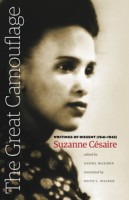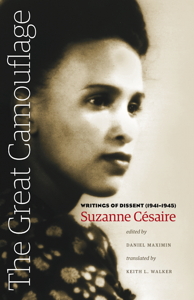 Edited by Daniel Maximin. Translated by Keith L. Walker
Edited by Daniel Maximin. Translated by Keith L. Walker
Publisher: Wesleyan University Press
Book Review by: Artha Hemrajani
Suzanne Cesaire (1915-1966) along with her husband Aime Cesaire helped start the Negritude movement. She was a French author from Martinique. This book contains seven articles she wrote for Tropiques, a cultural journal. She wrote these during the World War II years of the Vichy Regime in France and its territories. The island of Martinique was one of these, where she was born.
There were in all 14 issues of this journal. It was sometimes censored, sometimes shut down by the ruling authorities, and then republished at other times.
Daniel Maximin, who edited Cesaire’s materials for this book, is a Guadeloupean essayist, novelist and poet. His most recent book is Les Fruits de cyclone: Une geopoetique de la Caraibe.
Keith L. Walker is a professor of French and Italian at Dartmouth College and author or Countermodernism and Francophone Literary Culture.
Aime Cesaire was mayor of Fort de France, the island’s capital, for 56 years, from 1945 onwards. As such he was also a ‘deputy’ or representative from Martinique to the French National Assembly. He was a member of the Communist Party. When this party suppressed the Hungarian Revolution in 1956, he became disillusioned with it and quit as a member, as well as mayor. He was one of the drafters of the 1946 law that ‘departmentalized’ French colonies.
Suzanne Cesaire’s writings deal with many issues, but they all have to do with the central theme of camouflage, and related ideas of blindness and the imperative need for lucidity. To give you an overview of the issues in those seven articles, they are:
- Deception
- Self-deception
- The economic slipknot of the post-slavery debt system
- Political smokescreens
- Inauthenticity
- Bad faith
- Psychological and affective aberration, and
- Cultural ‘zombification’
Martinique is an island of 436 square miles located in the Antilles in the eastern Caribbean Sea, with a population of about 412,000 with a per-capita income of Euros 19,607 (US $25,880). To its northwest can be found Dominica; to its south is St. Luca and on the southeast lies Barbados.
While this island was discovered by Christopher Columbus in 1502, it appears (pending verification) that the French began to occupy and rule it as a ‘territory’ from 1635 onwards up to 1746. From that point onward, the island became a ‘department’ of France.
Suzanne Cesaire points out that for centuries, the Antilleans lived in poverty and under its ‘degradations’ and ‘humiliations’ and were ‘depraved’ under Caribbean ‘plantocracy.’
The people of Martinique were frequently urged by their French rulers to assimilate with the White world, which the author was vehemently against, as expressed in this passage from one of her articles:
“The Maritinician has failed because, unaware of his real nature, he tries to lead a life that is not his own. The gigantic phenomenon of a collective lie, of ‘pseudomorphosis’ how, why in this people, only yesterday slaves, can there be this fatal misunderstanding? By the most natural of processes, by the instinct for self-preservation game…and with the overwhelming force, a disastrous confusion takes place in his (the Martinician’s) mind: liberation means assimilation.
She wrote about the ‘double standards’ of the Revolution, the Declaration of the Rights of Man and the Enlightenment. These she perceived as the great camouflage of ‘Gallic humanist’ values of liberty, equality, fraternity and solidarity for Europe.
She pointed out about these ‘masked’ (the rulers’) policies of “enslavement based on the non-homogeneity of the human species, injustice and a color caste system for the colonial Antillean subjects abroad.”







